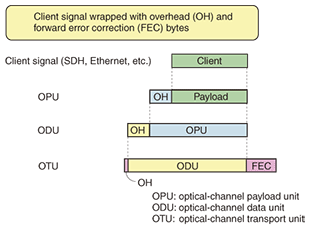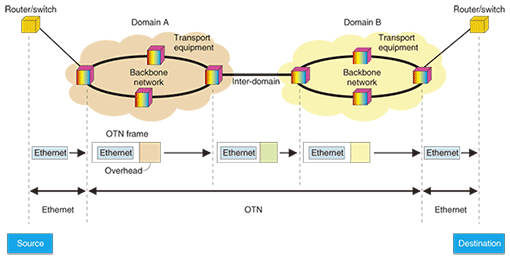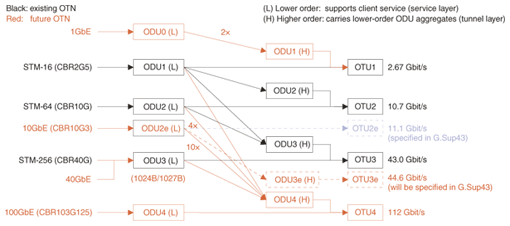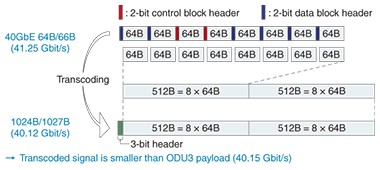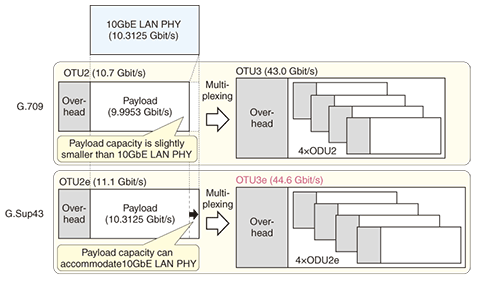 |
|||||||||
|
|
|||||||||
|
Global Standardization Activities Vol. 7, No. 3, pp. 53–58, Mar. 2009. https://doi.org/10.53829/ntr200903gls Standardization Activities for the Optical Transport NetworkAbstractThe standardized technology for the Optical Transport Network (OTN) is evolving drastically. ITU-T SG15 (International Telecommunication Union, Telecommunication Standardization Sector, Study Group 15) is discussing various OTN evolution topics, such as the support for 40G/100G Ethernet being standardized in IEEE. This article introduces recent standardization activities related to OTN evolution, especially Ethernet transport over OTN.
1. BackgroundThe synchronous digital hierarchy (SDH) is a standardized technology for time division multiplexed transport networks. It was standardized in 1988, when the dominant traffic on transport networks was voice traffic. The Optical Transport Network (OTN) was standardized in 2001. It provides advanced optical communication technologies such as optical paths and forward error correction suitable for wavelength division multiplexing (WDM) systems (Fig. 1). Three bit rates, 2.5, 10, and 40 Gbit/s, were specified in the OTN standard, corresponding to the SDH bit rates. WDM systems based on the OTN are now being deployed to support the continuous growth in traffic resulting from the shift from voice traffic to data traffic.
Especially notable in pushing this trend is Ethernet. In addition to 1G/10G Ethernet*, which is now used widely, higher-speed Ethernet, 40G/100G, is now under standardization in the IEEE 802.3ba Task Force. The maximum transmission distance in the Ethernet standards is 40 km, so wide-area Ethernet transport technologies are necessary to support, for example, the connection of Ethernet switches located at branch offices separated by more than 40 km. Ethernet transport over OTN, schematically shown in Fig. 2, is the technology that can provide this, and the demand for this technology is growing. Two standards development organizations, ITU and IEEE, are closely cooperating to produce this technology. ITU-T SG15 is responsible for OTN standardization [1] and IEEE 802.3ba is responsible for 40G/100G Ethernet standardization [2].
2. 40G/100G EthernetIEEE 802.3ba is addressing 40G as well as 100G Ethernet in the same project. The 40G/100G Ethernet standard will specify four kinds of interfaces, as shown in Table 1. The main usages of 40G Ethernet will be OTN access and future server interfaces, while the main usage of 100G Ethernet will be networking between Ethernet switches. The notable technical feature of 40G/100G Ethernet is multilane transmission. Multilane transmission for 40G/100G based on multiples of 10G, such as 4 × 10G or 10 × 10G, leverages the 10G technologies initially developed for SDH and now widely used for 10G Ethernet. On the other hand, the multilane transmission for 100G Ethernet based on 4 × 25G requires new optical technologies, which are not yet commercially available but still need to be developed. A key development issue here is low cost.
The fundamental specifications of 40G/100G Ethernet were fixed as Draft 1.0 in October 2008, and large-scale integrated circuits and optical modules are now being developed. Routers and switches using these devices will be released before the completion of standardization by around 2010 (Fig. 3).
3. OTN evolutionExisting OTNs have three kinds of optical-channel transport unit (OTU): OTU1 (payload capacity: 2.48832 Gbit/s), OTU2 (payload capacity: 9.99528 Gbit/s (= 238 ÷ 237 × 9.95328 Gbit/s)), and OTU3 (payload capacity: 40.15052 Gbit/s (= 238 ÷ 236 × 39.81312 Gbit/s)). These correspond to the SDH bit rates of STM-16 (2.48832 Gbit/s), STM-64 (9.95328 Gbit/s), and STM-256 (39.81312 Gbit/s). The important point in OTN evolution is how to support various client signals such as Ethernet while keeping interoperability with the existing OTN. To support new client signals, the future OTN will use the following two methods (Fig. 4): - specify a new optical-channel data unit (ODU) suitable for the new client and - specify a new mapping scheme to accommodate new clients in the existing ODU.
Examples of the former are ODU4 for 100G Ethernet and ODU2e for 10G Ethernet; an example of the latter is the mapping scheme that uses transcoding to accommodate 40G Ethernet in ODU3. Furthermore, 10G Fibre Channel will be accommodated in ODU2e by using transcoding. The following section introduces Ethernet transport over OTN. 4. 100G Ethernet transport: ODU4/OTU4A notable feature of 100G Ethernet standardization from the viewpoint of the OTN and Ethernet standardization history is that for the first time the data rate for wide area networks has fallen behind that of local area networks. ITU-T began discussing a new higher rate ODU/OTU, namely ODU4/OTU4, to support 100G Ethernet transport. Initially, ITU-T had several candidates for ODU4/OTU4, such as a payload capacity of 160 Gbit/s (a straightforward 4 × 40 Gbit/s) or 120 Gbit/s (a multiple of 40 Gbit/s but with relaxed limitations on the physical transmission). From the beginning of this discussion, NTT continued to propose the ODU4/OTU4 bit rate as being best suited for 100G Ethernet, i.e., specification of a payload capacity close to the 100G Ethernet bit rate (103.125 Gbit/s). As a result of the long discussion in Q11, the bit rate of 112 Gbit/s (payload capacity of 104.356 Gbit/s) was agreed for ODU4/OTU4. 5. 40G Ethernet transport: transcodingThe transcoding technique will be standardized to transport 40G Ethernet (41.25 Gbit/s) over the existing OTU3 (payload capacity: 40.15 Gbit/s). A 64B/66B Ethernet signal, in which every 64-bit block has a 2-bit header, is rearranged to offer an 8-block (512-bit) unit, as shown in Fig. 5. A 3-bit header is added to every 16 blocks (1024 bits) to produce a 1024B/1027B code, which was proposed by NTT. This transcoding technique can decrease the code redundancy (bit rate after transcoding: 40.12 Gbit/s) while retaining all user information and keeping bit error tolerance to achieve 40G Ethernet transport over OTU3.
6. 4 × 10G Ethernet transport: ODU3e/OTU3eA new ODU, called ODU2e, was specified in 2006 in supplement G.Sup43, which incorporated a Japanese proposal. It represents a pragmatic solution to 10G Ethernet transport over OTN because the bit rate of 10G Ethernet (LAN PHY: 10.3125 Gbit/s) is greater than the payload capacity of ODU2 (9.99528 Gbit/s). Given the rapid penetration of 40G transmission systems, the demand for the transport of 4×ODU2e over 40G transmission systems is increasing. ITU-T SG15 is accordingly studying a new ODU/OTU for 4×ODU2e transport. NTT is actively proposing a new ODU/OTU for 4×ODU2e multiplexing. ITU-T SG15 agreed to specify this new ODU/OTU as ODU3e/OTU3e. The bit rate of ODU3e/OTU3e is close to that of the existing ODU3/OTU3, so ITU-T retains ODU3/OTU3 in Recommendation G.709 (Interfaces for the Optical Transport Network (OTN)) and specifies ODU3e/OTU3e in Supplement G.Sup43 (Transport of IEEE 10GBASE-R in optical transport networks (OTN)), as shown in Fig. 6, in order to differentiate them.
7. Other topicsThere are various topics under discussion in OTN evolution: (1) Generic mapping procedure (GMP) GMP is being discussed to support various client signals and future new ones. It is a generic procedure for mapping a client signal with any bit rate less than the payload capacity to the ODU. It will lead to a flexible future-proof OTN. (2) Lower order, higher order (LO/HO) ODU This is a concept that makes it easy for OTN to accommodate a client signal with any bit rate. By distinguishing an LO ODU, which accommodates the client signal, from an HO ODU, which corresponds to the OTU carried by the wavelength (lambda), this scheme increases the flexibility from the viewpoint of client signal accommodation while keeping the number of physical bit rates per lambda (OTU bit rate). (3) ODU0 The lowest tier of the current OTN is OTU1 (payload capacity: 2.48832 Gbit/s). This causes difficulty in accommodating 1G Ethernet in the OTN efficiently. A new ODU, called ODU0, which has a bit rate of around 1.25 Gbit/s (half that of ODU1) has been agreed in order to accommodate 1G Ethernet efficiently. 8. Future activitiesIEEE will complete 40G/100G Ethernet standardization in 2010. ITU-T is discussing OTN evolution while keeping step with IEEE. OTN specifications related to 40G/100G Ethernet will take effect after the completion of 40G/100G Ethernet standardization. NTT will continue to contribute to both ITU-T and IEEE in order to ensure that a future-proof OTN standard is produced. AcknowledgmentOur standardization activities for 100G OTN and 40G Ethernet transport are partly supported by the Universal Link Project and the Lambda Access Project, respectively, of the National Institute of Information and Communications Technology (NICT) of Japan. References
|
|||||||||








